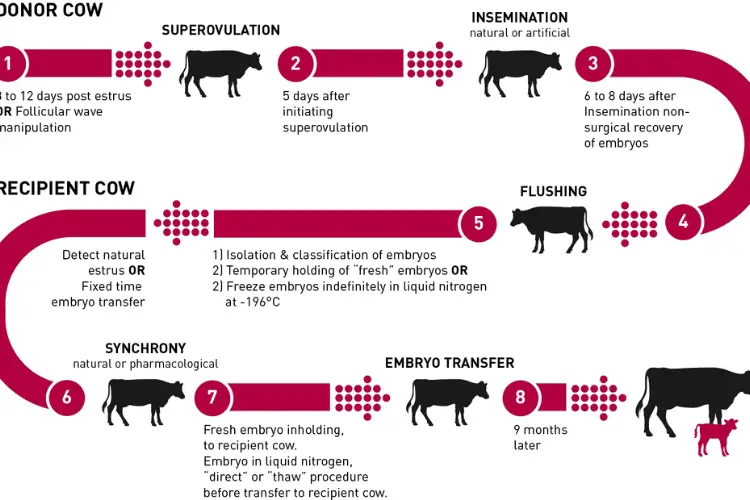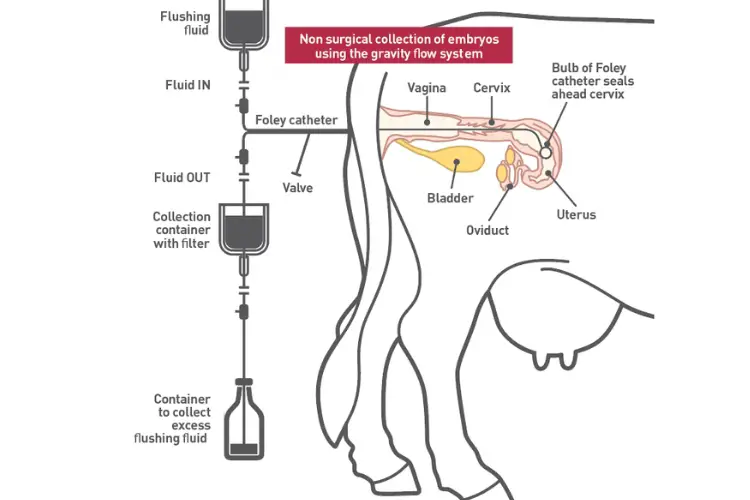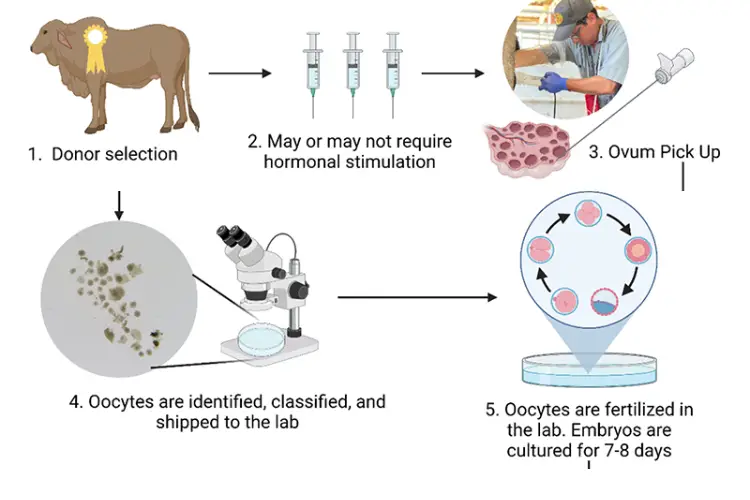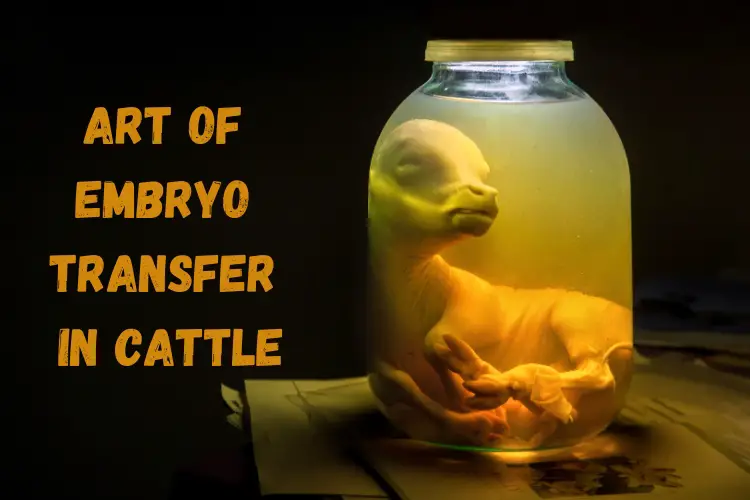Embryo transfer in cattle represents a significant advancement in agricultural biotechnology, offering breeders a powerful tool to enhance genetic progress and herd productivity.
We created this comprehensive guide for you. Dive into the intricacies of mastering embryo transfer, from understanding the underlying technology to maximizing success rates in the field.
It also addresses the genetic, regulatory, and ethical considerations critical for responsible and effective application of this technique in modern cattle breeding.
Key Takeaways
- Embryo transfer technology in cattle has revolutionized breeding practices, allowing for more precise genetic selection and rapid herd improvement.
- The success of embryo transfer depends on meticulous preparation, including synchronization of donor and recipient cows, and careful handling of embryos.
- Genetic considerations are paramount, with gene editing and genetic screening playing an increasingly significant role in breeding stock selection.
- Regulatory frameworks and ethical considerations surrounding gene editing and embryo transfer are complex and vary internationally, requiring careful navigation by breeders.
- Maximizing success rates involves understanding the factors that influence embryo transfer outcomes and implementing best practices to mitigate common complications.
Understanding Embryo Transfer Technology in Cattle

The Basics of Embryo Transfer
Embryo transfer in cattle is a biotechnological technique that allows for the reproduction of genetically superior livestock. The process starts with a donor cow, which is the selected female from whom embryos are to be collected.
These embryos represent the genetic material from both the sire and the dam, encapsulating the desired traits for the offspring.
The procedure involves several critical steps, beginning with the superovulation of the donor cow to produce multiple eggs. After fertilization, the embryos are harvested and assessed for quality. Only the embryos that meet the stringent criteria are then preserved for transfer or storage.
The recipient cows, which will carry the embryos to term, are carefully selected and synchronized to ensure they are at the optimal stage of their reproductive cycle for implantation.
Embryo transfer offers a multitude of benefits over traditional breeding methods, including the acceleration of genetic improvement, the ability to produce more offspring from valuable genetics, and the conservation of genetic resources. However, it requires meticulous planning and execution to achieve successful outcomes.
Advancements in Embryo Transfer Techniques
Embryo transfer technology in cattle has seen remarkable advancements over the years. Looking back at five decades of embryo technology in practice, we’ve witnessed a significant evolution.
The process has transitioned from the laborious and slow techniques of surgical recovery and transfer to the more efficient non-surgical methods. These advancements have not only improved the ease of the procedure but also increased the safety for both the donor and recipient animals.
Recent innovations include the development of transgenic techniques and the use of gene editing tools such as CRISPR-Cas9. These technologies have opened up new possibilities for genetic improvement and disease resistance in cattle. For instance, the creation of transgenic lines can lead to cattle with enhanced growth rates or improved milk production.
The table below summarizes some of the key advancements in embryo transfer technology:
| Year | Advancement | Impact |
|---|---|---|
| 1970s | Non-surgical recovery | Increased safety |
| 2000s | CRISPR-Cas9 gene editing | Precision breeding |
| Present | Transgenic techniques | Enhanced traits |
While these techniques offer many benefits, they also raise important considerations regarding animal welfare and ethical use. It is crucial to balance innovation with responsible practices to ensure the well-being of cattle and the sustainability of the industry.
Comparing Traditional Breeding and Embryo Transfer
When comparing traditional breeding methods to embryo transfer (ET) in cattle, it’s essential to consider both the advantages and limitations of each approach.
Traditional breeding has been the cornerstone of cattle reproduction for centuries, relying on natural mating or artificial insemination to produce offspring. This method is straightforward and cost-effective but offers limited control over genetic outcomes and slower genetic progress.
In contrast, ET allows for more precise genetic selection and faster genetic improvement by transferring embryos from genetically superior donor cows to recipient cows. This technique can significantly increase the efficiency of herd improvement programs. However, ET requires more specialized equipment and expertise, which can increase initial costs.
To illustrate the potential benefits of integrating ET, particularly with beef embryos into dairy herds, consider the following table:
| Aspect | Traditional Breeding | Embryo Transfer |
|---|---|---|
| Genetic Progress Speed | Slow | Fast |
| Control Over Genetics | Limited | High |
| Initial Investment | Lower | Higher |
| Expertise Required | Basic | Advanced |
| Potential for Revenue Boost | Moderate | High |
Farmers can capitalize on several potential benefits by strategically integrating beef embryos into dairy herds through IVF, with increased revenue at the core. The decision between traditional breeding and ET will depend on the specific goals and resources of the cattle operation.
The Procedure of Embryo Transfer in Cattle

Preparation and Synchronization of Donor and Recipient Cows
The success of embryo transfer in cattle heavily relies on the meticulous preparation and synchronization of donor and recipient cows. Synchronization is crucial as it ensures that the recipient cow’s estrous cycle aligns with the developmental stage of the transferred embryo.
This process typically involves the administration of hormones such as prostaglandin and GnRH (Gonadotropin-Releasing Hormone) to regulate the cycles.
A well-orchestrated protocol for synchronization includes several steps:
- Administration of synchronization drugs to both donor and recipient cows.
- Monitoring of estrous signs to confirm synchronization.
- Adjusting the timing of embryo collection and transfer based on the observed estrous cycle.
It is essential to maintain accurate records for each animal involved in the process. The table below summarizes the key aspects of the synchronization protocol:
| Aspect | Donor Cow | Recipient Cow |
|---|---|---|
| Hormone Administration | Prostaglandin, GnRH | Prostaglandin, GnRH |
| Estrous Monitoring | Required | Required |
| Timing Adjustment | Embryo Collection | Embryo Transfer |
By adhering to a rigorous synchronization schedule, the chances of successful implantation and pregnancy are significantly increased. It is also important to ensure that both donor and recipient cows are in optimal health to support the embryo transfer process.
Collection, Evaluation, and Storage of Embryos
The process of embryo transfer in cattle is highly dependent on the meticulous collection, evaluation, and subsequent storage of embryos.
Embryo collection is typically performed seven days post-insemination, ensuring that the embryos are at the right developmental stage for transfer. Once collected, embryos must be carefully evaluated for quality and viability, a critical step that determines the success of the transfer.
Storage of embryos is equally crucial. They are typically preserved at sub-zero temperatures, a practice that allows for long-term viability and flexibility in scheduling the transfer.
The embryos are labeled and stored immediately after collection, often at −20 °C, to maintain their integrity until they are ready to be implanted into recipient cows.
The following list outlines the key steps in the embryo collection and storage process:
- Collection of embryos from the donor cow
- Evaluation of embryo quality and developmental stage
- Labeling and immediate storage at appropriate temperatures
- Monitoring storage conditions to ensure long-term viability
Implantation and Post-Transfer Care
Following the delicate process of embryo implantation, the focus shifts to ensuring the best possible environment for the embryo to develop.
Careful monitoring of the recipient cow is crucial during this period. Hormonal support may be provided to enhance the chances of pregnancy maintenance, and nutritional needs must be meticulously managed.
The post-transfer period is a critical time where the success of the entire procedure is determined. It is essential to minimize stress and maintain a healthy herd environment. Regular veterinary check-ups are recommended to detect any complications early on.
To aid in understanding the post-transfer care, here is a list of key considerations:
- Close observation for signs of rejection or ill health
- Administration of prescribed hormonal treatments
- Nutritional management tailored to the cow’s needs
- Implementation of biosecurity measures to prevent disease
- Scheduled veterinary assessments and interventions as needed
Genetic Considerations and Selection of Breeding Stock


Genetic Screening and Selection Criteria
In the realm of cattle breeding, genetic screening plays a pivotal role in the selection of superior breeding stock.
The process involves evaluating various genetic markers that indicate desirable traits, such as milk production, growth rate, and disease resistance. Bull selection criteria are particularly comprehensive, encompassing performance data, Expected Progeny Differences (EPDs), and economic indexes, among other factors.
The selection criteria are not static; they evolve with advancements in genetic knowledge and technology. Breeders must stay informed and revise their strategies to incorporate emerging materials and techniques. For instance, the development of screening-level risk analysis tools has enabled a more nuanced understanding of the potential risks associated with new genetic materials.
To ensure a systematic approach, the following table summarizes key aspects of genetic screening:
| Aspect | Description |
|---|---|
| Performance Data | Historical records of animal productivity |
| EPDs | Predictions of an animal’s genetic potential |
| Gene Testing | Identification of specific genetic markers |
| Economic Indexes | Financial implications of breeding decisions |
By integrating these elements, breeders can make informed decisions that enhance the genetic quality of their herds while managing the economic viability of their operations.
The Role of Gene Editing in Breeding
Gene editing is a powerful new method that enables unprecedented control over genetic material and offers the opportunity to make rapid advances in cattle breeding. This cattle breed improvement has been achieved by discovering the genes through the comprehensive analysis of the entire genome of cattle.
The technology not only enhances precision and efficiency over current breeding methods but also opens up possibilities for climate change adaptation by targeting phenotypes beneficial in varying environmental conditions.
The application of gene editing in cattle breeding is not without its challenges and considerations. There is, as yet, no international consensus on the regulation of gene-edited organisms, which introduces uncertainties in the adoption of this technology.
Moreover, the ethical implications of gene manipulation and the potential for unintended consequences necessitate a careful examination of both the efficacy and safety of these practices.
- Emerging gene editing applications aim to improve a range of traits in livestock.
- Technical limitations and opportunities are being discussed in the context of climate change adaptation.
- The socio-political history of genetic engineering suggests the need for public engagement and careful policy development to avoid repeating past controversies.
Managing Genetic Diversity and Inbreeding
Maintaining genetic diversity within cattle breeds is crucial for ensuring robust health and performance. Inbreeding depression, a reduction in biological fitness, is a significant risk when genetic diversity is not preserved. This can lead to an increase in the prevalence of hereditary diseases and a decrease in fertility and overall productivity.
To combat these issues, breeders can implement strategies such as outcrossing, where animals from different genetic backgrounds are mated, and rotational breeding, which involves alternating between sires from distinct genetic lines.
Additionally, the use of genomic information can help identify animals with desirable traits while minimizing the risk of inbreeding.
- Outcrossing to introduce new genetic material
- Rotational breeding to diversify sire lines
- Genomic screening to select optimal breeding pairs
It is essential to strike a balance between improving genetic traits and preserving genetic variability to support good performance and avoid inbreeding depression. The table below summarizes the approaches to managing genetic diversity:
| Strategy | Description | Expected Outcome |
|---|---|---|
| Outcrossing | Mating of unrelated individuals | Increased genetic variability |
| Rotational Breeding | Alternation between sires from different genetic lines | Sustained diversity within a breeding program |
| Genomic Screening | Use of DNA information to guide breeding decisions | Reduced risk of hereditary diseases |
Regulatory and Ethical Aspects of Embryo Transfer

International Regulations and Consensus
The landscape of international regulations for embryo transfer in cattle is complex, with various countries adopting different approaches to governance. Harmonized regimes are widely recognized as beneficial for streamlining product development and commercialization.
For instance, the European Union has specific directives, such as Decision (EC) 2006/168, which stipulates that cloned embryos are not permitted for import, reflecting a cautious stance on certain biotechnologies.
Experts often debate the efficacy of different regulatory frameworks. Some argue that neither the permissive policies of the United States nor the restrictive measures of the European Union are based solely on scientific evidence, but rather on a mix of politics, economics, and culture.
This highlights the need for regulations that are responsive to societal desires and concerns while overcoming implementation barriers.
To illustrate the diversity of international regulations, consider the following points:
- Harmonization of regulations can facilitate product development.
- Flexibility and reduced bureaucracy are crucial for acquiring key lab materials, especially in countries with less developed regulatory systems.
- Stakeholder engagement, including public and private partnerships, is essential for transparent and inclusive regulation.
Ethical Implications of Genetic Manipulation
The ethical landscape of genetic manipulation in livestock, particularly through techniques such as gene editing, is complex and multifaceted. Public trust is a cornerstone of advancing biotechnological innovations responsibly.
The lack of transparency in gene-edited crops and livestock can lead to a distrust among consumers, potentially stalling the adaptation to future biotech products.
A broader conversation on the underlying ethics of gene editing is essential. It is not just about the scientific feasibility but also about aligning with societal values and ensuring that the benefits outweigh the risks.
The study of gene engineering in livestock, such as somatic cell nuclear transfer (SCNT), has revealed side effects and abnormal reprogramming issues, highlighting the need for careful consideration and oversight.
Social concerns associated with cisgenic crops and gene-edited livestock include health, environmental impact, consumer acceptance, and the well-being of agricultural producers. These concerns must be addressed to ensure the safe and sustainable use of gene editing technologies:
- Health implications of consuming gene-edited products
- Environmental consequences of altering ecosystems
- Consumer perceptions and market acceptance
- Agricultural sustainability and producer benefits
Public Engagement and Policy Development
The development of policies surrounding embryo transfer in cattle necessitates a robust framework for public engagement. As highlighted by the International Embryo Technology Society, the surge in embryo production and transfers globally underscores the need for inclusive dialogue and policy development.
Stakeholder engagement is crucial in shaping policies that are transparent and trusted. Innovative online platforms have emerged as effective tools for gathering diverse stakeholder perspectives, which are essential for the creation of well-informed policies.
These platforms facilitate a collaborative environment where stakeholders can voice their concerns and contribute to the policy-making process.
To ensure that public engagement is meaningful and productive, it is important to adopt best practices. The following list outlines key steps for successful engagement:
- Establish clear objectives for engagement
- Identify and include a broad range of stakeholders
- Provide stakeholders with relevant and accessible information
- Encourage open and respectful dialogue
- Collect and report feedback to inform policy decisions
By integrating these steps, policymakers can build a stronger evidence base for stakeholder engagement, leading to more effective and acceptable policies in the realm of cattle breeding technologies.
Maximizing Success Rates and Overcoming Challenges

Factors Influencing Embryo Transfer Success
The success of embryo transfer in cattle is contingent upon a myriad of factors, each playing a pivotal role in the outcome. Environmental conditions, such as temperature and humidity, can significantly affect the viability of embryos.
Additionally, the health and nutritional status of both donor and recipient cows are critical for successful implantation and gestation.
Proper handling and transfer techniques are also essential to maintain the integrity of the embryos. The expertise of the technicians and the quality of the equipment used can greatly influence success rates. Below is a list of key factors that contribute to the success of embryo transfer in cattle:
- The synchronization of estrous cycles between donor and recipient cows
- The quality and developmental stage of the collected embryos
- The precision of the embryo transfer procedure
- The post-transfer management and care of the recipient cow
By meticulously addressing these factors, practitioners can enhance the likelihood of a successful embryo transfer, leading to improved genetic advancement and herd productivity.
Addressing Common Complications

In the realm of embryo transfer in cattle, practitioners may encounter a range of complications that can affect the success rates of the procedure. Early identification and management of these issues are crucial to ensuring the health of both the donor and recipient animals, as well as the viability of the embryos.
Common complications include improper synchronization of estrous cycles, infections, and physiological reactions to the transfer process. To effectively address these complications, a systematic approach is recommended:
- Synchronization failures: Adjust hormonal protocols and closely monitor estrous signs.
- Infections: Implement strict biosecurity measures and provide appropriate antibiotic treatments.
- Physiological reactions: Minimize stress through proper handling and create a conducive environment for implantation.
By adhering to best practices and remaining vigilant for signs of distress or abnormality, veterinarians and farmers can mitigate the risks associated with embryo transfer. Continuous education and training in the latest techniques also play a pivotal role in overcoming these challenges.
Case Studies and Best Practices
The culmination of research and practical experience in the field of embryo transfer has led to the development of best practices that are pivotal for the success of the procedure.
Case studies have been instrumental in refining these practices, providing insights into the nuances of embryo transfer in various scenarios. For instance, studies have highlighted the importance of rigorous synchronization protocols between donor and recipient cows to maximize the chances of successful implantation.
Best practices also emphasize the need for meticulous evaluation and handling of embryos. This includes the assessment of embryo quality and the use of precise storage techniques to preserve viability. The table below summarizes key aspects of best practices derived from case studies:
| Aspect | Description |
|---|---|
| Synchronization | Timing of hormonal treatments for donors and recipients |
| Embryo Evaluation | Criteria for selecting viable embryos |
| Storage | Methods for maintaining embryo integrity |
Adopting these best practices can lead to improved outcomes and support the overarching goal of embryo transfer: to enhance genetic lines and develop disease-free animals. It is essential to continuously update these practices as new advancements and knowledge emerge from ongoing research and field applications.
Conclusion
Mastering the art of embryo transfer in cattle is not just about the technical precision it requires; it’s about understanding the broader context of agricultural innovation and its implications.
As we’ve explored throughout this guide, the integration of advanced reproductive technologies like embryo transfer is a testament to the ongoing evolution of agrifood production. While these technologies offer remarkable opportunities for efficiency and genetic advancement, they also come with a responsibility to consider regulatory frameworks, ethical considerations, and the impact on ecosystems.
The future of cattle breeding is poised at the intersection of tradition and innovation, where the wisdom of past practices meets the transformative potential of modern science. By embracing a comprehensive approach that weighs the merits and demerits of these advancements, stakeholders can ensure a sustainable and prosperous future for the cattle industry.
FAQs:
What are the basic steps involved in embryo transfer in cattle?
Embryo transfer in cattle involves several key steps: synchronizing the donor and recipient cows’ estrous cycles, collecting embryos from the donor cow post-fertilization, evaluating and storing viable embryos, and finally, implanting the embryos into the synchronized recipient cows.
How does embryo transfer technology compare to traditional breeding methods?
Embryo transfer allows for more precise genetic selection and faster herd improvement compared to traditional breeding. It enables the multiplication of genetics from top-quality donor cows, which can be more efficient than relying on natural mating or artificial insemination alone.
What are the latest advancements in embryo transfer techniques?
Recent advancements in embryo transfer include improved protocols for superovulation, more accurate synchronization methods, and enhanced embryo cryopreservation techniques. Additionally, innovations in genetic screening and gene editing are playing an increasing role in selecting and enhancing desirable traits.
What genetic considerations are important when selecting breeding stock for embryo transfer?
When selecting breeding stock for embryo transfer, it’s crucial to consider genetic diversity, heritable traits, potential for inbreeding, and overall genetic health. Genetic screening can help identify desirable traits and eliminate genetic disorders from the breeding pool.
What are the ethical implications of gene editing in cattle breeding?
Gene editing raises ethical questions regarding animal welfare, potential impacts on ecosystems, and long-term effects on genetic diversity. It also prompts discussions about the balance between technological progress and natural breeding processes.
Are there international regulations governing the use of embryo transfer and gene editing in cattle?
Currently, there is no global consensus on the regulation of gene-edited organisms. Countries vary in their regulatory approaches, with some having well-defined frameworks for genetically modified and gene-edited animals, while others are still developing their policies.


